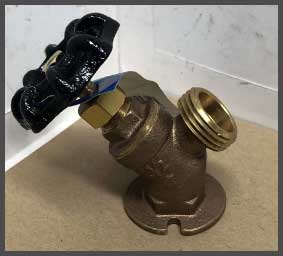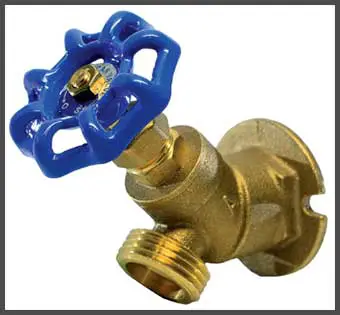Have you ever found yourself caught between ½ inch and ¾ inch sillcock?
It can be a real pain, especially when you have to make a quick decision. But with my 1/2 vs. 3/4 sillcock review, you might not feel that the same way.
Whether planning for a new plumbing project or restoring a damaged one, you might have to decide between these two sillcock sizes. And you can do it in the right way when you know about them in detail.
I will give you a comprehensive comparison between the two sizes. So, let’s begin.
A Quick Comparison Table
Here is a quick comparison table between ½” and ¾” sillcock:
| Feature | 1/2″ Sillcock | 3/4″ Sillcock |
| Flow Rate | Lower flow capacity around 4-5 GPM | Higher flow capacity around 7-10 GPM |
| Pressure Rating | Typically around 125 PSI maximum | Typically around 125 PSI maximum |
| Cost | Lower, around $15 to $30 range | Higher, around $25 to $50 range |
| Size/Weight | Compact and lightweight | Bulkier in size and heavier |
| Ease of Installation | Easier to install in tight spaces | A bit harder to install due to larger size |
| Durability | Durable but prone to freezing more often | Very durable and freeze resistant |
| Applications | Residential outdoor usage with short hoses | Commercial usage or long hoses for pressure |
In-Depth Comparison Between ½” And ¾” Sillcock
You have gathered a basic idea from the above comparison table. Now it’s time we get into more details. So, here are some key differences between ½” and ¾” sillcock:
- Product Type

Sillcock is a water faucet generally placed at sill height on the outside of your house.
People usually attach a hose with it.
Some people also call it a hose cock or hose bib.
A ½ inch sillcock allows you to attach ½ inch hose with it.
On the other hand, a ¾ inch sillcock allows attaching a ¾ inch hose.
- Features
Regardless of size, sillcock is generally made from Brass with heavy Brass construction. It has external or male threads to accept a hose coupling with a female thread.
Most sillcock comes with a neoprene seal disc.
Plus, you’ll get a convenient notched flange for easy installation. Nevertheless, a ½ inch sillcock is comparably a new product. At the same time, a ¾ inch sillcock is a classic and most used size.
- Flow Rate
One of the most noticeable differences between 1/2 inch and 3/4 inch sillcocks is water flow capacity. The wider diameter of a 3/4 inch faucet allows significantly more water to flow through at once.
Typical flow rates are:
- 1/2 inch sillcock – 4 to 5 gallons per minute (GPM)
- 3/4 inch sillcock – 7 to 10 GPM
So if your main goal is to maximize water flow, such as filling a pool or running sprinklers to cover a large lawn, a 3/4 inch model can deliver the higher volume you need. The tradeoff is it’s overkill for simpler garden hose uses like washing your car.
And some building codes actually prohibit larger 3/4 inch sillcocks for residences to conserve excess water usage.
- Benefits
The main benefit of a ½ inch hose is that it carries just enough water you need for gardening.
So, no chance of wasting water.
Another benefit is its price. You will have to spend less money for a ½ inch sillcock.
On the contrary, a ¾ inch will cost more than a ½ inch sillcock. But it will carry more water too.
- Performance
A ¾ inch sillcock performs better than a ½ inch one. You will get more water pressure from ¾” sillcock. That is why this is the most common sillcock size.
But you have to remember that the water pressure also depends on hose length. So. If you have a long hose, a ¾ inch sillcock will carry more water.
- Installation Comparison

Tying into size differences, installing 3/4 inch sillcocks requires a wider hole through your wall.
This can present challenges working in tight spaces between framing.
The smaller 1/2 inch faucet openings give you more positioning flexibility.
Also consider Do-It-Yourself skills working with copper tubing connections.
The 1/2 inch size is simpler for amateur home plumbing. Stepping up to 3/4 inch compresses the work area and uses larger pipe diameters.
Finally, make sure your main water lines provide adequate pressure for increased 3/4 inch flow capacity. Otherwise you won’t gain the intended benefits over 1/2 inch models after all the extra installation effort.
- Durability Differences
When evaluated for ruggedness, 3/4 inch sillcocks are very durable given their reinforced construction to handle higher pressures and volume. This resists both wear-and-tear and freezing.
That said, modern 1/2 inch faucets hold up very well too under normal conditions. Only if you require maximum freeze resistance should durability factor into your size decision. Proper seasonal draining provides adequate protection for most regions either way.
- Intended Applications
Taking all the factors together, you can best match a sillcock size with your intended application:
For typical residential usage:
- Garden hoses up to 50 feet
- Watering plants or grass areas
- Washing cars, outdoor furniture, etc.
- Occasional filling of pools, tubs, or moderate use
…a 1/2 inch sillcock provides the best functionality without overspending.
For commercial settings or to meet higher water flow capacities:
- Long run garden hoses over 50 feet
- Frequent filling of very large vessels
- Higher pressure output up to 10 GPM
- Increased freeze/abuse resistance
…step up to a 3/4 inch sillcock to meet maximum flow and durability demands.
Bottom line, while 3/4 inch models outperform 1/2 inch overall, don’t overspend without requiring the extra flow capacities in residential use-cases. A value-priced 1/2 inch sillcock adequately serves typical outdoor faucet needs.
- Price
Another difference between these two sillcock sizes is their price. A ½ inch sillcock will cost around $13. On the contrary, you will have to spend about $17 for a ¾ inch sillcock.
Which Sillcock Is Best For You?

From the above discussion, I think which sillcock you should purchase is pretty clear. You should definitely go for ¾ inch sillcock.
It’ll cost you some extra bucks but look on the bright side.
You’ll get high-pressure and enough water down the hose pipe. Just make sure your hose pipe is compatible with your sillcock.
Frequently Asked Question (FAQ)
You should use a pipe size that is compatible with your hose bib. A ¾ inch pipe and hose bib will give you more water pressure.
Traditional hose bibs are one or two inches long. But sillcock is generally 6 to 30 inches long for protection against cold weather.
½” PEX works fine for short distances like dishwashers and sinks. But for more pressure, you’ll need a ¾ inch PEX.
A sillcock and a hose bib are technically the same things with different names.
Conclusion
Choosing the right sillcock size comes with a lot of benefits. The most important one is you’ll get a proper flow of water.
So, I hope now you understand the importance of it.
It turns out that choosing between 1/2 vs. 3/4 sillcock is easier than you thought. So go ahead and purchase the right sillcock and make your life easy.

Hi Ralph, my name is Joe. I’m in New Hampshire and replacing both of my outdoor faucets so I’m looking for a 3/4” sillcock, preferably with anti siphon and frost free features.
As I look for a 3/4” version I find loads of 1/2” versions from Boshart & Quarter Turn. These models have a 3/4” MPT, but as you look at the drawings, the opening from the inlet pipe adapter looks to be 1/2” Are you aware of a good 3/4” sillcock that meets my requirements?
Of note look at this Boshart drawing, paying attention to the inlet opening right next to the pipe adapter:
https://boshart.com/wp-content/uploads/product-assets/2953b07f8dac20b54688f551ce0310aee5941778_08QTWH_No_Lead_Non_Freeze_Lawn_Faucets.pdf
Let me know if you can recommend a solution
Thanks
Joe Funk
Feel free to call if that’s easier
603-361-664